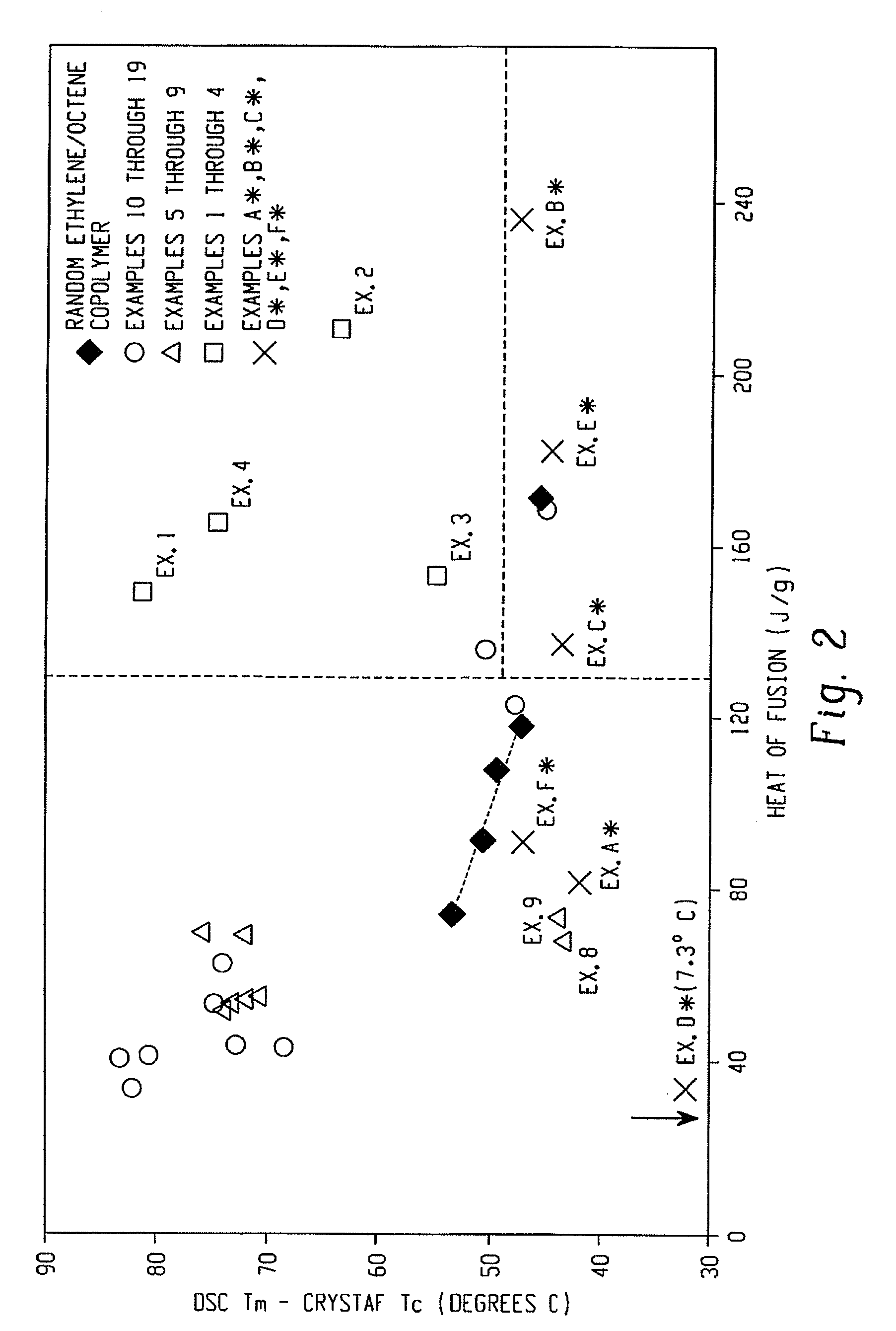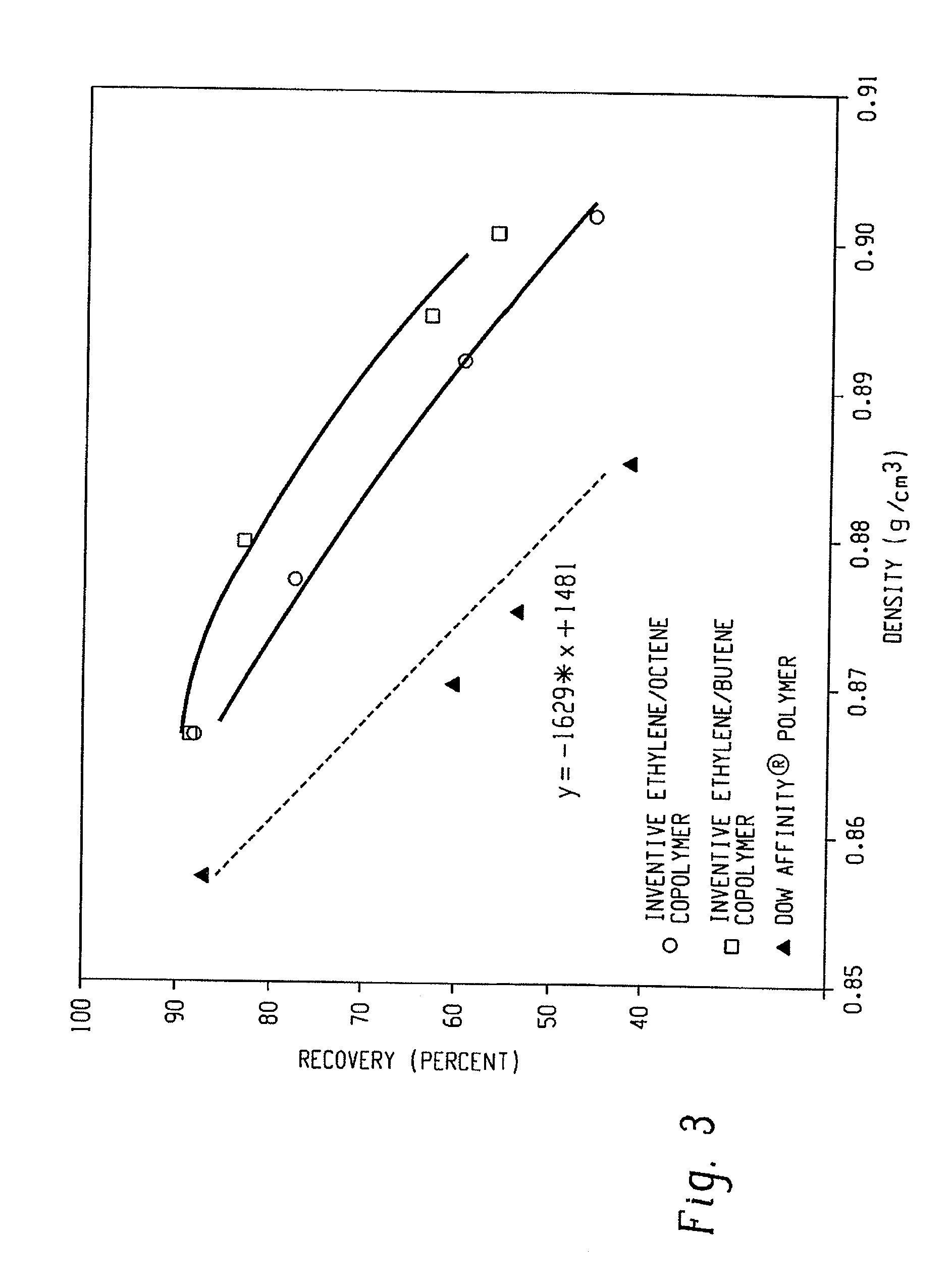Polyurethane Compositions and Articles Prepared Therefrom, and Methods for Making the Same
a technology of polyurethane and composition, which is applied in the field of polyurethane composition, can solve the problems of high cost, high cost, and high cost of polyurethane, and achieve the effect of reducing the cost of polyurethane production, and improving the adhesion and compatibility of polyurethane with more polar polymeric materials
- Summary
- Abstract
- Description
- Claims
- Application Information
AI Technical Summary
Problems solved by technology
Method used
Image
Examples
examples 1-4
Comparative A-C
General High Throughput Parallel Polymerization Conditions
[0239]Polymerizations were conducted using a high throughput, parallel polymerization reactor (PPR) available from Symyx technologies, Inc., and operated substantially according to U.S. Pat. Nos. 6,248,540, 6,030,917, 6,362,309, 6,306,658, and 6,316,663. Ethylene copolymerizations are conducted at 130° C. and 200 psi (1.4 MPa), with ethylene on demand, using 1.2 equivalents of cocatalyst 1, based on total catalyst used (1.1 equivalents when MMAO is present). A series of polymerizations are conducted in a parallel pressure reactor (PPR), contained of 48 individual reactor cells in a 6×8 array that are fitted with a pre-weighed glass tube. The working volume in each reactor cell is 6000 μL. Each cell is temperature and pressure controlled, with stirring provided by individual stirring paddles. The monomer gas and quench gas are plumbed directly into the PPR unit, and controlled by automatic valves. Liquid reagent...
examples 5-19
Comparatives D-F
Continuous Solution Polymerization, Catalyst A1 / B2+DEZ
[0250]Continuous solution polymerizations were carried out in a computer controlled autoclave reactor equipped with an internal stirrer. Purified mixed alkanes solvent (Isopar™ E available from ExxonMobil Chemical Company), ethylene at 2.70 lbs / hour (1.22 kg / hour), 1-octene, and hydrogen (where used) are supplied to a 3.8 L reactor equipped with a jacket for temperature control and an internal thermocouple. The solvent feed to the reactor is measured by a mass-flow controller. A variable speed diaphragm pump controls the solvent flow rate and pressure to the reactor. At the discharge of the pump, a side stream is taken to provide flush flows for the catalyst and cocatalyst 1 injection lines and the reactor agitator. These flows are measured by Micro-Motion mass flow meters and controlled by control valves or by the manual adjustment of needle valves. The remaining solvent is combined with 1-octene, ethylene, and h...
examples
A. Aqueous Dispersions
[0447]Aqueous dispersions may be prepared by melt blending the inventive composition and water in an extruder to produce a stable, uniform dispersion with an average particle size, typically around 300 nm. The solids content of the dispersions is typically from 35 to 50 weight percent, based on the total weight of the dispersion. A dispersing agent, for example, UNICID™ 350 acid (6 wt % on a solids basis; of a synthetic C2-6 carboxylic acid converted to potassium salt, and available from Baker Petrolite), is added to the dispersion. The dispersions are then applied as a cast film to biaxially-oriented polypropylene (BOPP) film, and the surface energy measured.
[0448]The compositions of the invention may also be used as an adhesion promoter to polyurethane, either pure or in blends, extruded to provide artificial turf (or artificial grass yarn).
[0449]For example, an inventive composition may be extruded on a tape extrusion line and stretched 5 times. Sample tapes...
PUM
| Property | Measurement | Unit |
|---|---|---|
| angles | aaaaa | aaaaa |
| elongation | aaaaa | aaaaa |
| hr | aaaaa | aaaaa |
Abstract
Description
Claims
Application Information
 Login to View More
Login to View More - R&D
- Intellectual Property
- Life Sciences
- Materials
- Tech Scout
- Unparalleled Data Quality
- Higher Quality Content
- 60% Fewer Hallucinations
Browse by: Latest US Patents, China's latest patents, Technical Efficacy Thesaurus, Application Domain, Technology Topic, Popular Technical Reports.
© 2025 PatSnap. All rights reserved.Legal|Privacy policy|Modern Slavery Act Transparency Statement|Sitemap|About US| Contact US: help@patsnap.com



